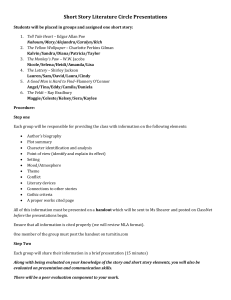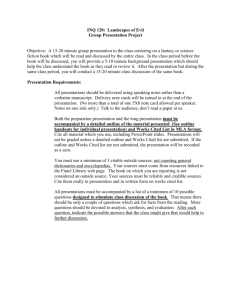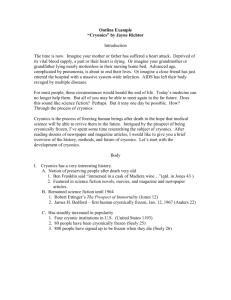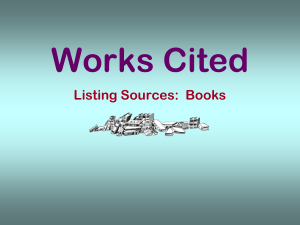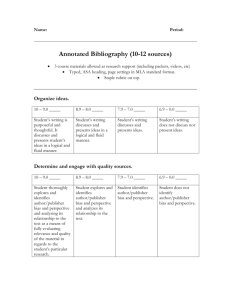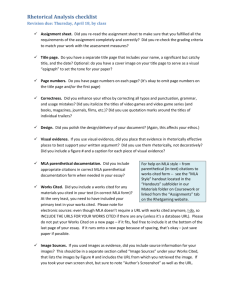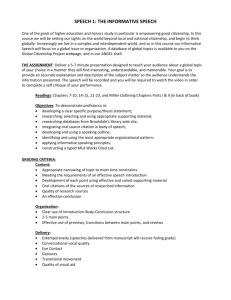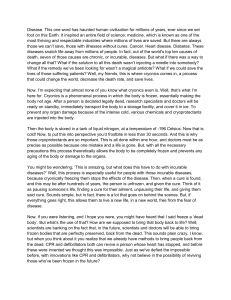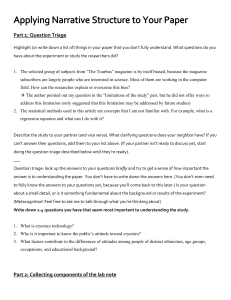INQ 120 Presentation Assignment: Landscapes of Evil
advertisement
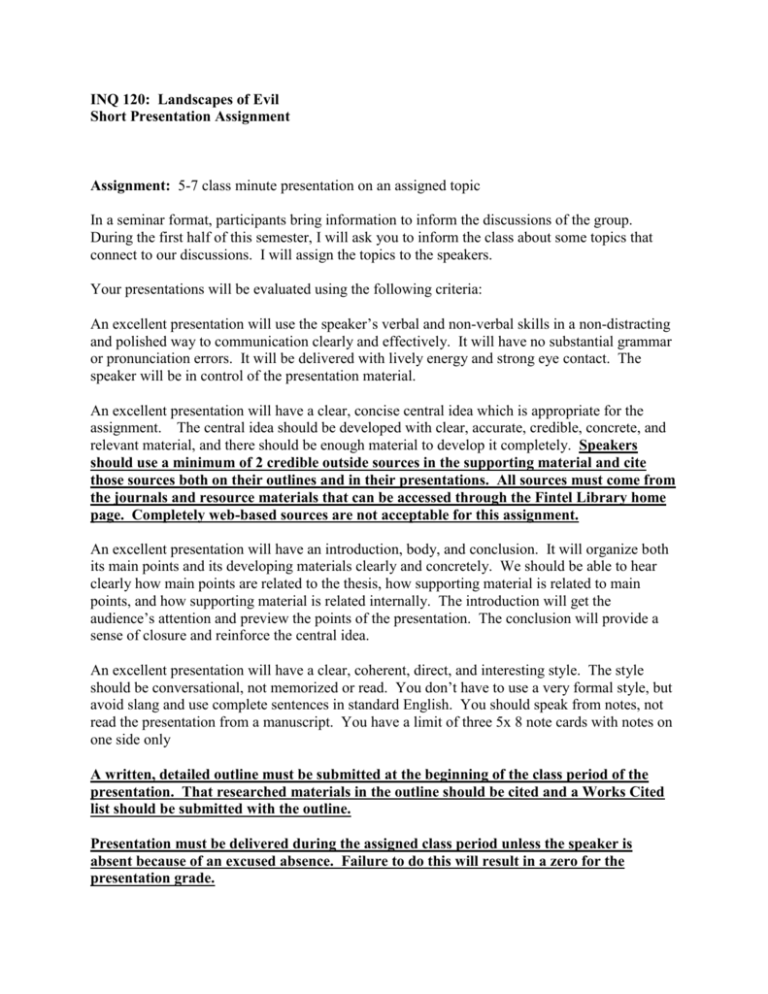
INQ 120: Landscapes of Evil Short Presentation Assignment Assignment: 5-7 class minute presentation on an assigned topic In a seminar format, participants bring information to inform the discussions of the group. During the first half of this semester, I will ask you to inform the class about some topics that connect to our discussions. I will assign the topics to the speakers. Your presentations will be evaluated using the following criteria: An excellent presentation will use the speaker’s verbal and non-verbal skills in a non-distracting and polished way to communication clearly and effectively. It will have no substantial grammar or pronunciation errors. It will be delivered with lively energy and strong eye contact. The speaker will be in control of the presentation material. An excellent presentation will have a clear, concise central idea which is appropriate for the assignment. The central idea should be developed with clear, accurate, credible, concrete, and relevant material, and there should be enough material to develop it completely. Speakers should use a minimum of 2 credible outside sources in the supporting material and cite those sources both on their outlines and in their presentations. All sources must come from the journals and resource materials that can be accessed through the Fintel Library home page. Completely web-based sources are not acceptable for this assignment. An excellent presentation will have an introduction, body, and conclusion. It will organize both its main points and its developing materials clearly and concretely. We should be able to hear clearly how main points are related to the thesis, how supporting material is related to main points, and how supporting material is related internally. The introduction will get the audience’s attention and preview the points of the presentation. The conclusion will provide a sense of closure and reinforce the central idea. An excellent presentation will have a clear, coherent, direct, and interesting style. The style should be conversational, not memorized or read. You don’t have to use a very formal style, but avoid slang and use complete sentences in standard English. You should speak from notes, not read the presentation from a manuscript. You have a limit of three 5x 8 note cards with notes on one side only A written, detailed outline must be submitted at the beginning of the class period of the presentation. That researched materials in the outline should be cited and a Works Cited list should be submitted with the outline. Presentation must be delivered during the assigned class period unless the speaker is absent because of an excused absence. Failure to do this will result in a zero for the presentation grade. If your presentation is due on the same day as a reflective writing assignment, you will be excused from the completion of that assignment. Due Dates: Thursday, Jan. 21- Beowulf Neil Gaiman Tuesday, Jan. 26- Confucius Confucian Virtues: Li, Hen, Yi Confucius’ “ideal Gentlemen Thursday, Jan 28- St. Augustine Theodicy and Free Will City of God and City of Man Parable of the Sower (Bible-Matthew 13:1-23) Tuesday, Feb. 9- Lao-Tzu and the Toa Te Ching Philosophical Taoism and the Tao Wu-Wei, Tzu-Jan, Te Thursday, Feb. 11 Karl Jung Archetype Joseph Campbell Hero Monomyth Thursday, Feb. 18 Satan 19th Century Romanticism INQ 120: Landscapes of Evil Outline Format -Write out introduction verbatim and identify preview statement. Use MLA in-text citation form for documentation of introductory material. -Start outline of body with Roman Numeral I. Use standard outline indentation and numerals State main points in complete declarative sentences. Supporting material does not have to be arranged into complete sentences; however, it must be specific and detailed enough for someone to understand its gist immediately and evaluate its appropriateness. For example, if you were outlining the first major point while 1 speaking in detail about Picasso’s first painting: A. First painting incomplete A. First painting at 8 years old incomplete A. First painting, The Picador at 8 years old complete and specific Use parenthetical documentation in outline to indicate source of material. Use MLA form for documentation For example: A. First painting, The Picador at 8 years old. (Jones 22) - Write out conclusion verbatim. Use MLA in-text citation form for documentation. - Use MLA style for Works Cited List Outline Example “Cryonics” by Jayne Richtor Introduction The time is now. Imagine your mother or father has suffered a heart attack. Deprived of its vital blood supply, a part or their heart is dying. Or imagine your grandmother or grandfather lying nearly motionless in their nursing home bed. Advanced age, complicated by pneumonia, is about to end their lives. Or imagine a close friend has just entered the hospital with a massive system-wide infection. AIDS has left their body ravaged by multiple diseases. For most people, these circumstances would herald the end of life. Today’s medicine can no longer help them. But all of you may be able to meet again in the far future. Does this sound like science fiction? Perhaps. But it may one day be possible. How? Through the process of cryonics. Cryonics is the process of freezing human beings after death in the hope that medical science will be able to revive them in the future. Intrigued by the prospect of being cryonically frozen, I’ve spent some time researching the subject of cryonics. After reading dozens of newspaper and magazine articles, I would like to give you a brief overview of the history, methods, and future of cryonics. Let’s start with the development of cryonics. Body I. Cryonics has a very interesting history. A. Notion of preserving people after death very old 1. Ben Franklin said “immersed in a cask of Madiera wine…”(qtd. in Jones 43 ) 2. Featured in science fiction novels, movies, and magazine and newspaper articles. B. Remained science fiction until 1964 1. Robert Ettinger’s The Prospect of Immortality (Jones 12) 2. James H. Bedford – first human cryonically frozen, Jan. 12, 1967 (Anders 22) C. Has steadily increased in popularity 1. Four cryonic institutions in U.S. (United States 1193) 2. 80 people have been cryonically frozen (Seely 25) 3. 800 people have signed up to be frozen when they die (Seely 26) II. When a person who has signed up to be cryonically frozen dies, a specific procedure must be carried out. (Seely 54-60) A. Person must decide whether the whole body or the head should be frozen B. If the whole body, it must be preserved. 1. Immediately after death, connected to heat-lung machine 2. Chemicals circulated to prevent tissue damage 3. Cold packs used to reduce internal temperature C. If only the head is used 1. Head surgically detached and preserved in separate container 2. Why someone would choose to preserve only head a. body may be in very poor condition b. hope that science would be able to create new body in future D. Once head or body is ready, process proceeds 1. Cryoprotectorants circulated to reduce cell damage 2. Over 20 days, body or head cooled to negative 320 degrees a. Stored in steel cylinder of liquid nitrogen to maintain temperature b. Biological function stops and patient will not change for hundreds of years (“Deep Freeze” 67) III. Two major issues in the future of cryonics are its high cost and the need to perfect the freezing and rethawing process A. Cost from $60,000 - $125,000 (Anders 72) 1. Can be paid for by life insurance 2. Facing own mortality more difficult than getting the money B. Details of freezing and rethawing aren’t worked out 1. Freezing inflicts a large amount of cell damage (“Limits of Immortality” 33) a. Only a few types of human tissue can be frozen and thawed successfully b. Not possible now to freeze and rethaw complicated organs, much less bodies or brains 2. Scientists working on ways to reduce damage caused by freezing process (“Deep Freeze” 65) a. Researching better cryoprotectorants to control cell damage b. Developing microscopic machines to repair cells at molecular level Conclusion In closing, we have seen that cryonics is much more than a plot in a science fiction novel. It has developed from a wholly unrealistic fantasy to the point that 80 people have already been frozen and hundreds more have made the choice to be cryonically frozen when they die. If scientists can ever figure out how to rethaw people successfully, we can be sure that cryonics will become much more popular. So think again of your father or mother suffering a heart attack, your grandmother or grandfather dying of pneumonia, or your close friend stricken with AIDS. If they chose to be buried or cremated in traditional fashion, their physical minds and bodies would be destroyed. That is absolutely certain. By contrast, being cryonically frozen offers some small chance that they may be revived in the future. Even if that chance is small it’s more than no chance at all. In addition, you must submit a Works Cited page using MLA format. INQ 120: Landscapes of Evil Presentation Evaluation Form Speaker __________________________________________________ Topic _________________________ ___ Time Rate the speaker on each point: G-good E-excellent Grade A-average F-fair P-poor 1. Introduction gained attention and interest E G A F P 2. Introduction previewed body of presentation clearly E G A F P 3. Main points appropriate and mutually exclusive E G A F P 4. Main points clearly organized and easy to follow E G A F P 5. Main points supported with sufficient and accurate material E G A F P 6. Evidence from appropriate sources E G A F P 7. Reasoning clear, sound, and easy to follow E G A F P 8. Language appropriate, clear, and concise E G A F P 9. Conclusion relevant to presentation purpose and memorable E G A F P 10. Sufficient eye contact E G A F P 11. Style controlled, direct, and fluent E G A F P 12. Voice used effectively E G A F P 13. Physical delivery effective E G A F P 14. Outline and Works Cited page appropriate and clear E G A F P Comments: _________________________________________________________________________ ____________________________________________________________________________________ ____________________________________________________________________________________ ____________________________________________________________________________________ ____________________________________________________________________________________ ____________________________________________________________________________________ ____________________________________________________________________________________ The Human Journey II Presentation Assignment Objective: A 10-20 minute individual presentation to the class centering on important figures in human culture. Requirements: - All presentations should be delivered using speaking notes rather than a verbatim manuscript. (No more than 4 5X8 note cards, notes on one side only. Do not substitute 8 3X5 cards or 2 pages of typing paper. The object is to get what you need in front of you with the least amount of fumbling and the greatest amount of eye contact.) Delivery cards will be handed in following the presentation. - All presentations must be accompanied by a detailed outline of the material presented (See attached format model) and Works Cited List in MLA format. - All presentations must be accompanied by a class handout that emphasizes the most important points of the presentation in a coherent and succinct way. These should not be the same as your presentation outline. That outline should be very detailed. Handouts should be clearly organized and easily understandable. Make them useful for your classmates to review the topic later. They should be detailed enough to be that useful, but not a verbatim copy of your presentation. On the day you do your presentation, you must submit a copy of your handout with your outline and Works Cited list. If you use Power Point with your presentation, also turn in a master copy of your Power Point slides. - You must use a minimum of 5 outside sources, no more than 2 of which may be entirely web-based sources. The databases used by the library are not entirely web-based. They are electronic copies of published works. You may use as many of them as you wish. When you use web-based sources make sure they are reliable and serious. While you may use material from general encyclopedias or dictionaries in your presentation, you may not include that material as one of your 5 required sources. Encyclopedias are often useful for helping you find more detailed and better sources, but you need to go beyond them in your research. Notes: These presentations should not just be a big, generalized biographical report. Think about how your person made a difference to human culture. Why was he or she important? Describe his or her contributions carefully and fully. Choose the details you discuss to give us a general picture of what kind of person he or she was and then go in depth on his or her contribution to our world. We don’t need to know where your subject went to elementary school or that he or she moved to Paris at age 10, unless that made an impact on his or her contributions. If an event did make an impact on the subject’s work, tell us explicitly how it was connected. Don’t give us dry and unimportant details. Give us a sense of personality and how that personality affected what your subject produced and the culture that received it. Explain his or her work and define any unfamiliar terms. If you are speaking about an artist, show us some of his or her work, talk about it specifically, and connect it directly to what you your discussions of the person. Don’t just use it as wallpaper. If you are speaking about a musician, let us hear his or her music and connect it specifically to his or her contributions. A good presentation has many of the same requirements as a good paper. Be clear about your central ideas. Organize coherently around those ideas. Use simple, clear, interesting language. Be careful about over-reliance on only one or two sources for your information. Keep the material in your own words, supported with short quotations or paraphrases from your sources. Cite your sources orally in the presentation. Talk to us, don’t deliver a paper at us. Get our attention quickly in the introduction. Preview your main points and organization at the end of the introduction specifically, so we can have something in mind from the beginning to organize the information in our memories. Give us something memorable to close your presentation in the conclusion. Audio/Visual aids can help us understand complicated material or put it in better perspective. They can make your presentation more interesting. Remember that they are supporting information and should be integrated into your speech in the same way that any bit of supporting information should be. If you choose to use Power Point, please experiment with the equipment in this classroom so that you will know how to operate it smoothly and if your material works with it. Think of Power Point as a series of visual aids. Use them strategically to give the audience important information to add to what you are saying. Under no circumstances should the Power Point be the outline of your presentation that you are handing in to me or a copy of your handout. While a chronological organization would be O.K., don’t let your speech sound like a long list of brief events in your creator’s life. “And then he did this…and then she did this…and then he did this…” Use a variety of developing materials. Look for stories, descriptions, quotations from the subject or other sources, explanations of theories or contexts, etc. The Human Journey Presentation Critique Speaker: Scale: Time: 5 Excellent 4 Good Grade: 3 Average 2 Fair 1 Poor Comments: I. Content A. General Central Ideas Use of vivid and appropriate language Pronunciation/articulation B. Introduction Gained attention and interest Established topic clearly Previewed the body of the speech clearly C. Body Main points (appropriate, balanced, etc.) Supporting/developing material (research, citation, etc.) Material adapted for audience Maintained audience interest and attention D. Conclusion Reinforced central idea Provided good sense of closure E. Written Material Outline Works Cited List Class Handout II. Organization Appropriate to purpose Clear and easy to follow (in main points and in supporting material Important information emphasized IV. Delivery Energy level Eye contact General vocal delivery General physical delivery Control Conversational style Effective use of visual aid IL 277: Fantasy in Children’s Literature and Film Oral Presentation Assignment Objective: A 10-15 minute individual presentation to the class centering on a children’s book which will be read and discussed by the class. On the same class day, you will conduct a 15-20 minute class discussion of the same book. Presentation Requirements: All presentations should be delivered using speaking notes rather than a verbatim manuscript. (No more than 4 5X8 note cards, notes on one side only.) Talk to the audience, don’t read a paper at us. All presentations must be accompanied by a detailed outline of the material presented (see attached model) and Works Cited List in MLA format. Presentation will not be graded unless a properly cited outline and Works Cited list is submitted. If a properly cited outline and Works Cited list is not submitted, the presentation will be recorded as a zero. You must use a minimum of 3 outside sources, not counting general dictionaries and encyclopedias. The book on which you are reporting is not considered an outside source. Your sources must be reliable and credible sources. Presentations might include: Material centering on the author: This does not mean that you would give us a big generalized biographical section. Think about your authors and their books. Choose details of the authors’ lives that have some bearing on their work and especially on the works we will be reading in class. We don’t need to know where your authors went to elementary school or that they moved to Paris at age 10, unless that had an impact on their work. If an event did make an impact on the author’s work, tell us explicitly how it was connected. Don’t give us dry and unimportant details. Material centering on history or cultural context: What was going on in the larger world might have an impact on the work or explain some facet that we might not understand. These contexts might indicate important social or cultural issues that the author has chosen to discuss. For example, Alice in Wonderland might be connected to Romanticism or the Victorian age. The Wizard of Oz may be connected to political movements of 19th century America. Material centering on genre: There are many subdivisions within the world of children’s and young adult fantasy. Is this a piece of high fantasy? Is it a supernatural story? These imply elements that might be explored further in the presentation or the discussion. Material centering on themes and images: What are the primary themes and images that play themselves out in your work? How are they developed? Material centering on critical issues that we cover in class or that you discover in research: Can you apply any of the critical material that we read and discuss in class to your book? Other material which you find important, interesting or revealing about the work. Develop your presentation with a variety of material. Don’t let it sound like a long list of stuff. Organize it so that it makes sense to your audience and is easier for them to remember. Make the organization plain in the presentation itself. Look for stories, descriptions, quotations from the subject or other sources, explanations of theories or contexts, etc. Handouts that give us your important points in an organized and readable fashion might be helpful additions to your presentation and discussion. They are not required. You may use Power Point if you wish, but make sure that you use it effectively and allow time for the set-up. Discussion Requirements: Prepare for the discussion with a good number of relevant and interesting questions on a variety of levels to illicit audience responses. Include in your written work a list of the questions you might ask and some answers that you might anticipate receiving for each question. (You may not need to ask all the questions.) You need to submit a separate list of discussion questions even if you choose to integrate the discussion into your presentation (see below). You may conduct the discussion either before or after your presentation. You may mix your presentation and discussion in a kind of interactive presentation, if you wish. If you decide to do that, remember to keep your organization in mind and keep reminding your audience about where you are so that they won’t get lost. A mixed presentation should be 25-35 minutes long. Everyone in the class will be leading a discussion. Keep in mind that you will help your classmates by being an active participant. If you are responsive, they may be more likely to return the favor when it is your turn to lead. Everyone is expected to participate in a collaborative and respectful way. You may feel strongly about your opinions and defend them emphatically, but you should avoid displays of anger or pettiness. Do not monopolize the conversation, but feel free to explain your viewpoint. Failure to participate in a respectful way will result in points being deducted from your final grade. Don’t neglect the possibility of applying the critical readings and ideas we will talk about to the work you are discussing. Take into account both the assignments for that day and those which we have already read. You can also bring up comparisons or contrasts with other books which we may have read earlier, but make sure that those comparisons are significant to the discussion of your book and the issues that are important to it. Summary of Written Work To Be Submitted: - Outline of presentation cited with MLA parenthetical citations - Works Cited list in MLA format - Separate list of planned discussion questions with anticipated responses for each question written below it. - Copy of all PowerPoint slides if you are using PowerPoint - Delivery notes Written work must be submitted at the beginning of the class period in which you are speaking. Fantasy in Children’s Literature and Film Oral Presentation Critique Speaker: Time: Grade: Comments I. Presentation Content 25% II. Organization and Style 20% III. Discussion 20% IV. Delivery 20% V. Written Material 15%

